Abstract
Familial canine dermatomyositis in collie dogs is a newly recognized spontaneous disease that resembles dermatomyositis in children. A litter of 9 collie dogs was studied from birth to 7.5 months of age. The onset and severity of dermatitis and myositis correlated with elevated serum levels of circulating immune complexes (CICs) and IgG. The immunoglobulin component of the CICs consisted principally of IgG. All dogs developed elevated levels of CIC before or concurrent with the onset of dermatitis. Myositis developed later. The CIC tended to peak between 14-18 weeks of age in all dogs except the most severely affected dog, in which the CICs continued to increase to 238 micrograms/ml (controls 30 micrograms/ml) at 7 months of age. In the moderately affected dogs the CICs tended to stabilize at the levels reached at 14-18 weeks, and in the mildly affected dogs the CICs tended to decrease to normal levels after 14-18 weeks. Although the dogs had electromyographic and repetitive nerve stimulation abnormalities, the abnormalities did not correlate with severity of dermatomyositis or degree of elevation of CICs or IgG. Necropsy at 7.5 months of age revealed that all dogs had myositis and 8 of 9 had dermatitis. Except for 1 dog, the severity of dermatomyositis correlated positively with higher levels of CICs. A strong positive association between elevated levels of CICs and IgG, but not IgM or IgA, was generally present. Elevated levels of CICs appear to be involved in the mechanisms that control the development, severity, and progression of dermatomyositis in collie dogs.
Full text
PDF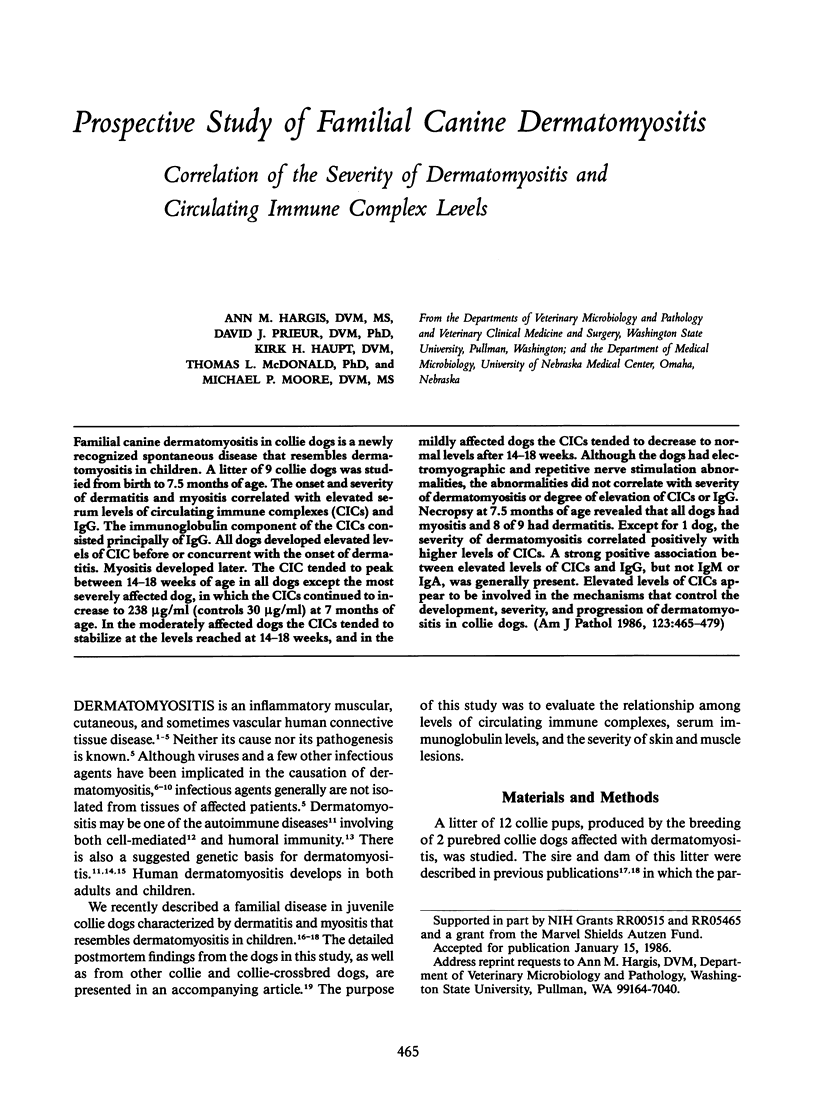
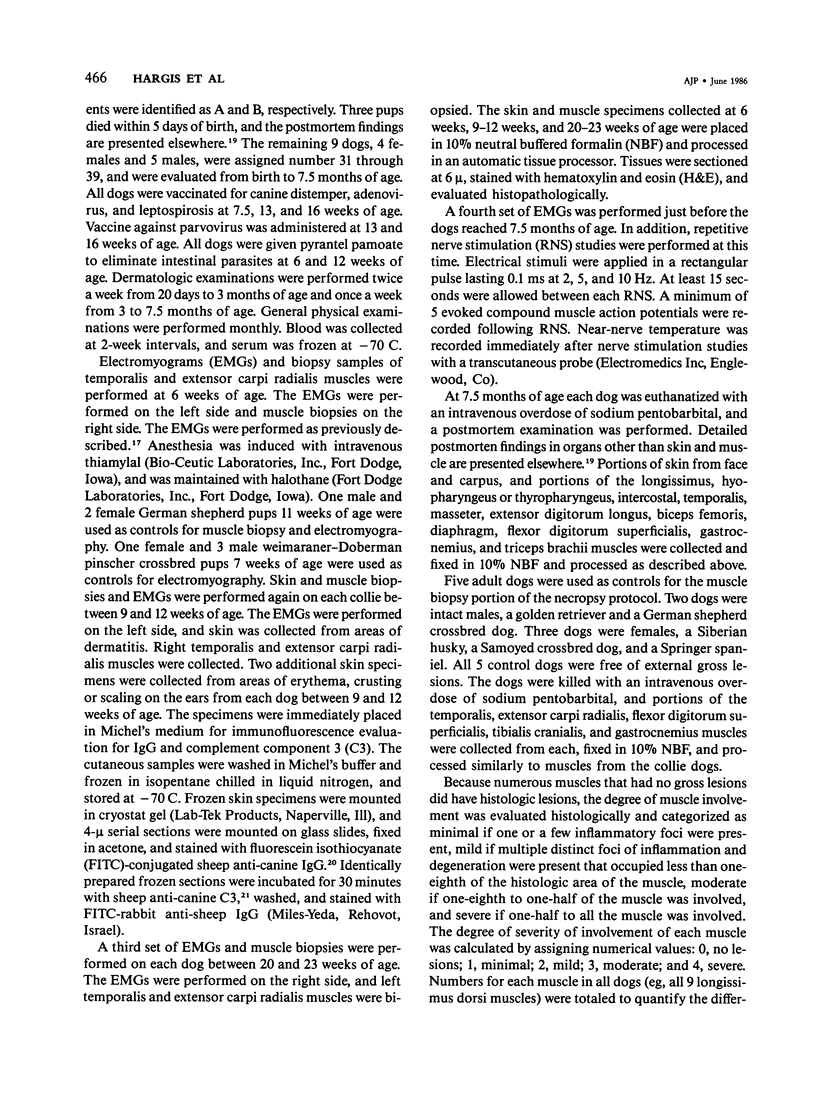
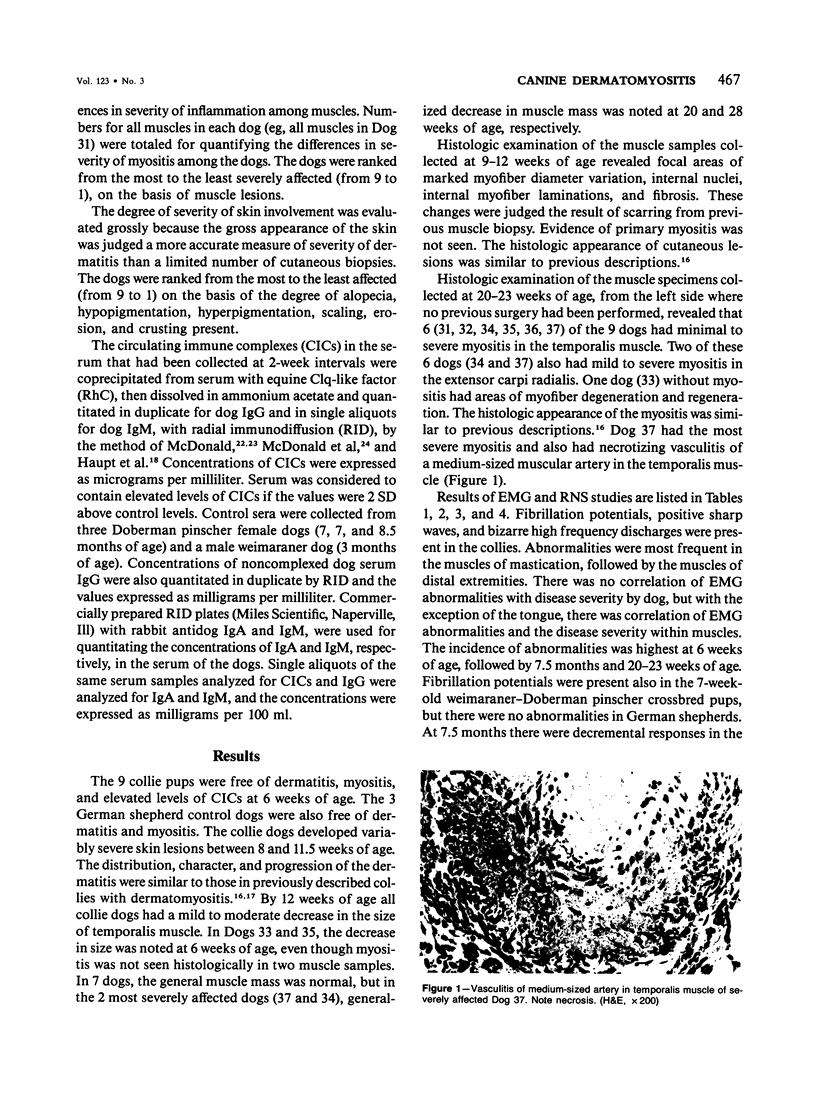
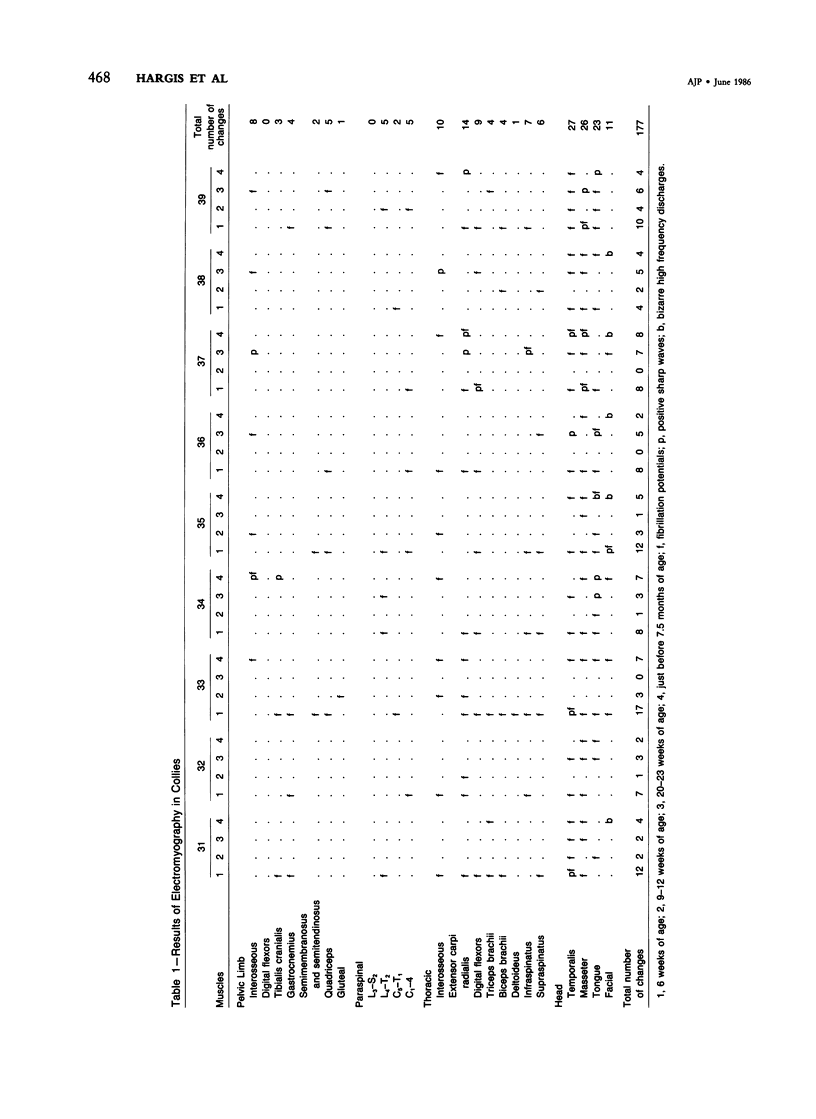
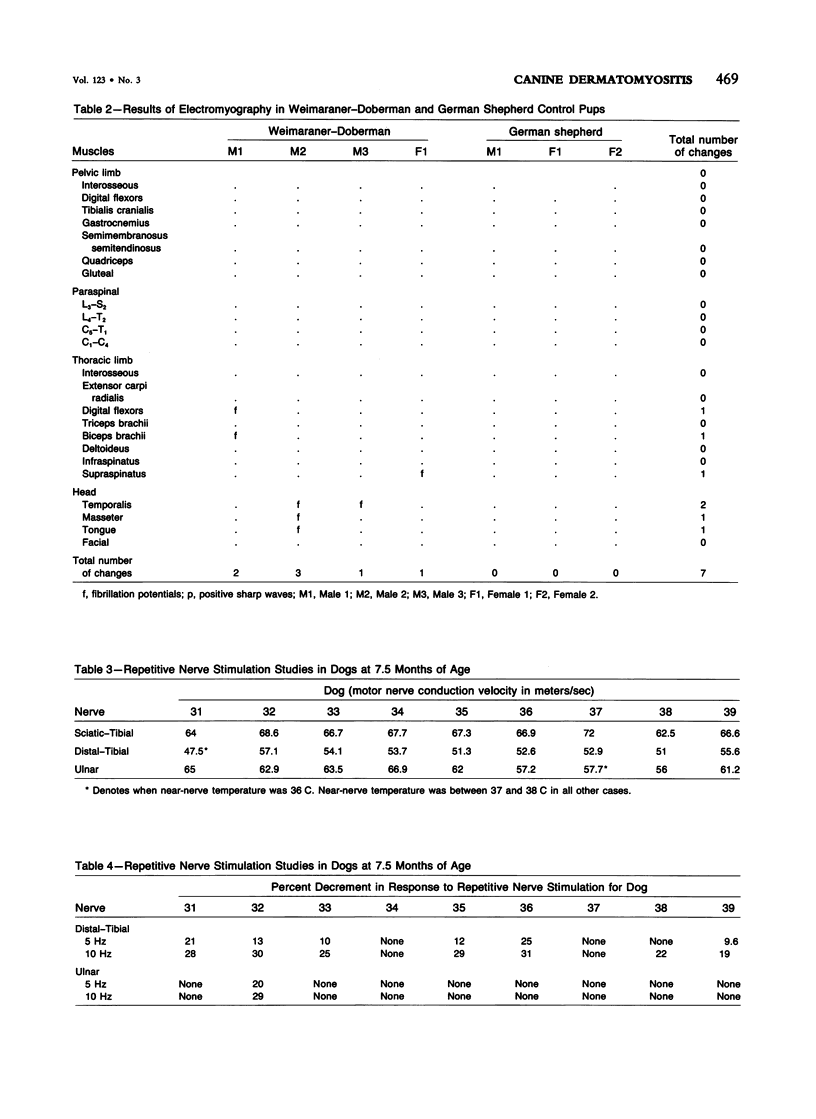
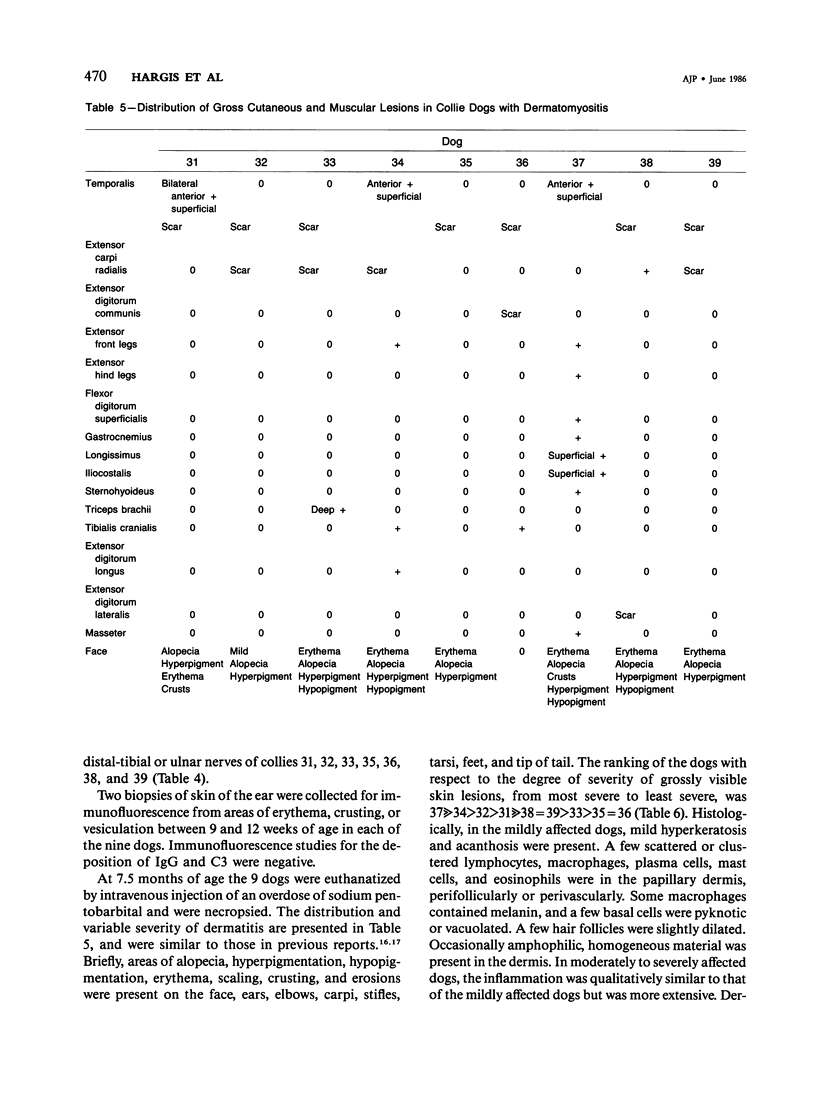
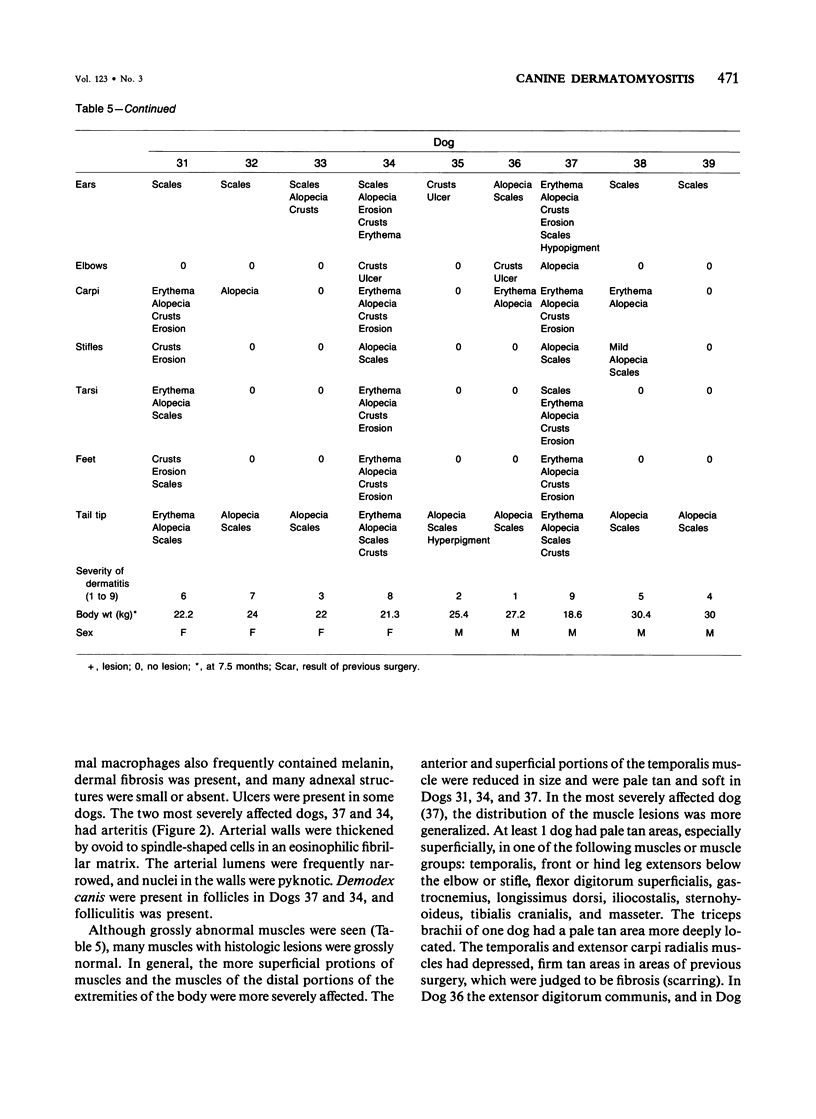
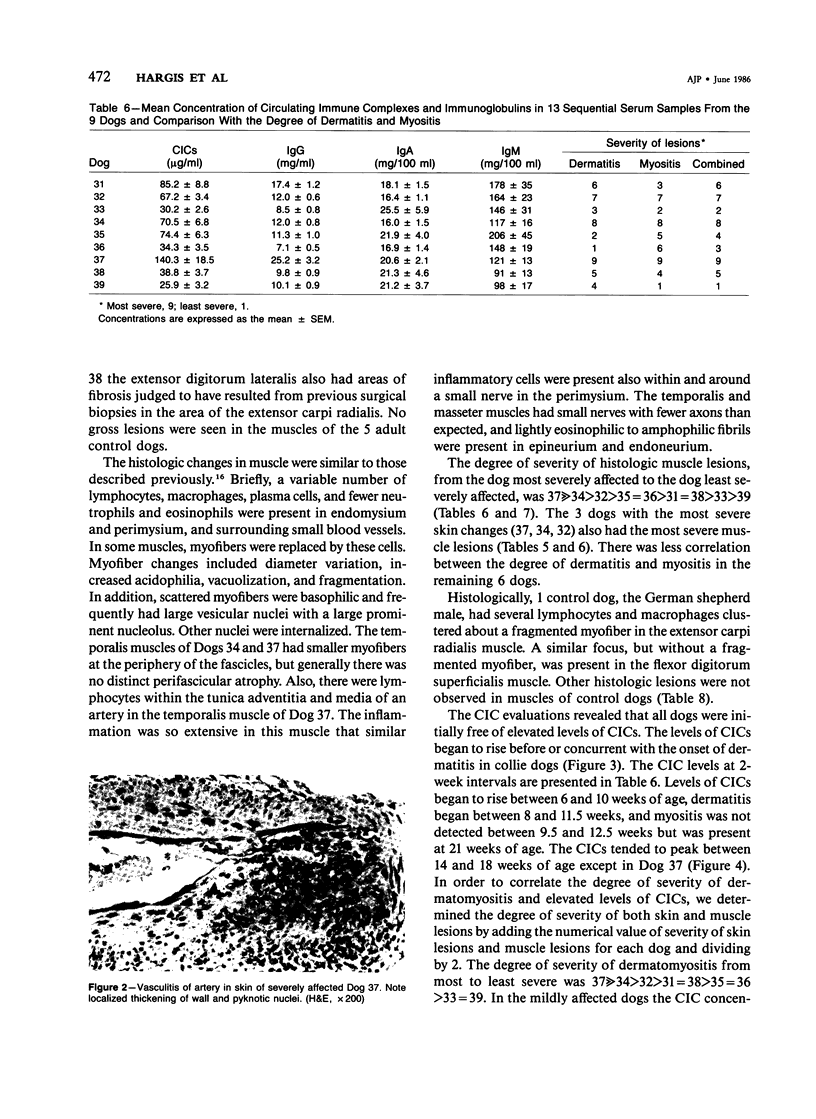
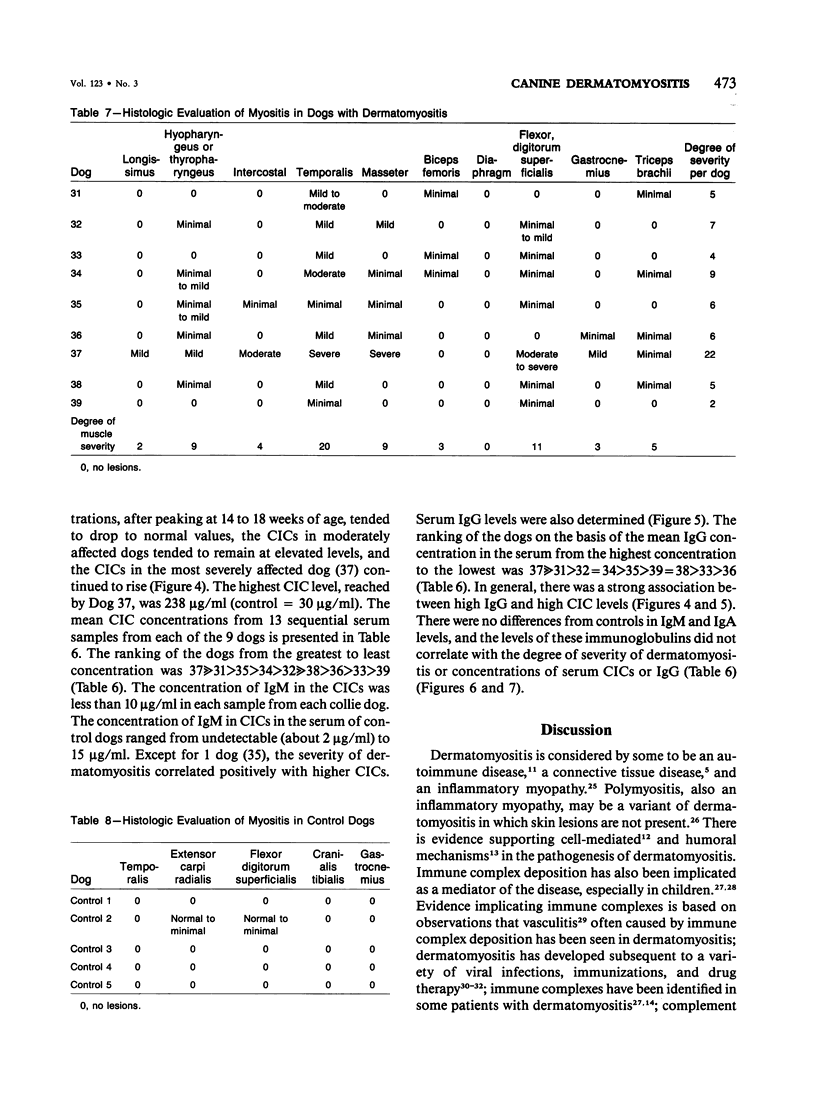
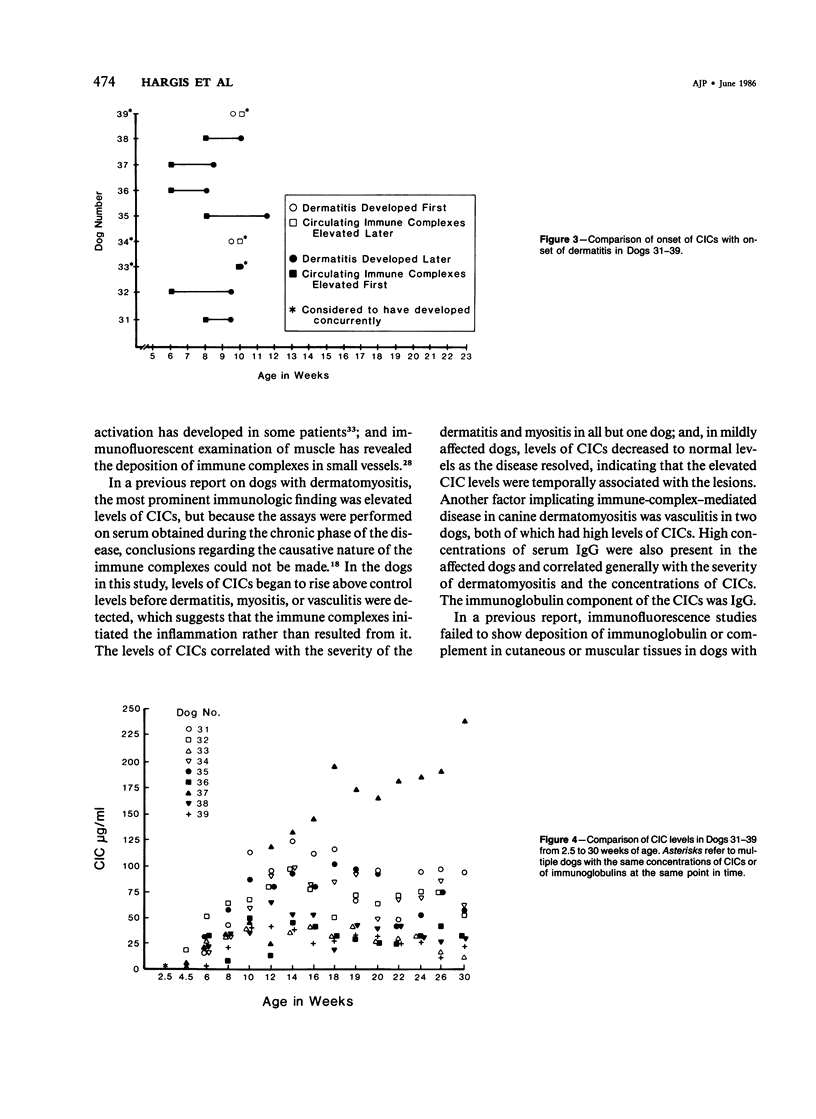
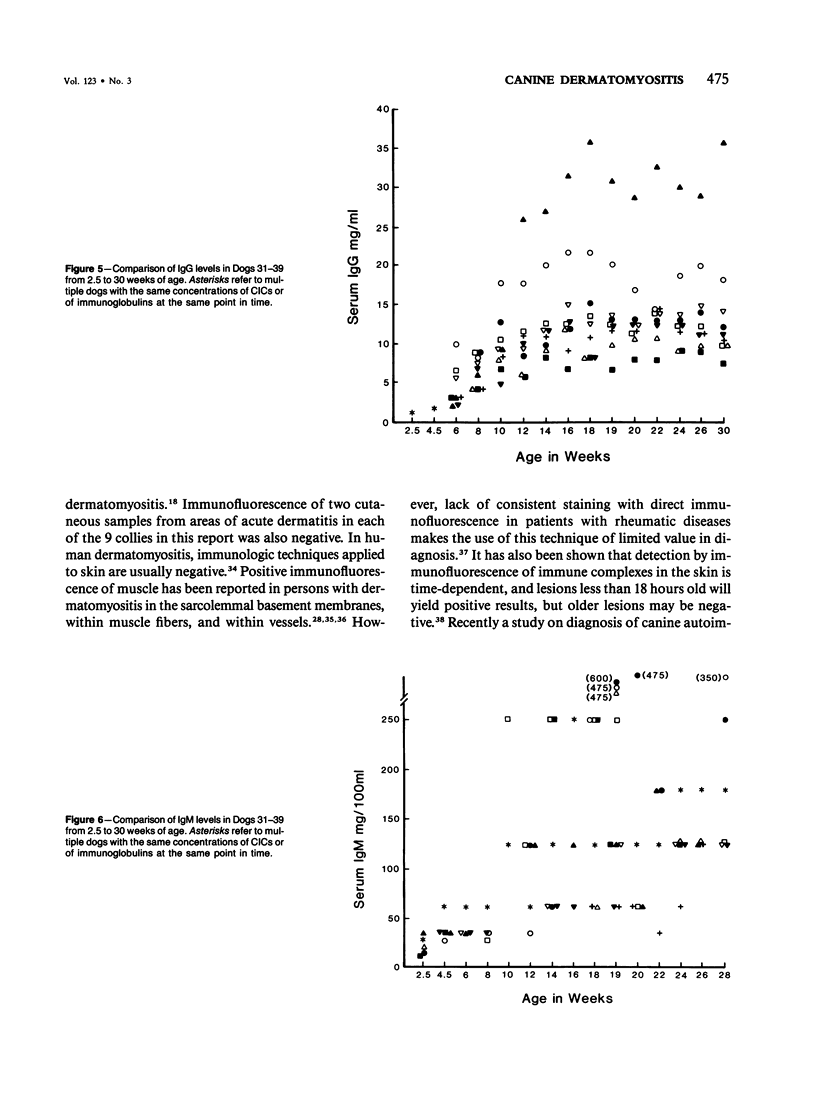
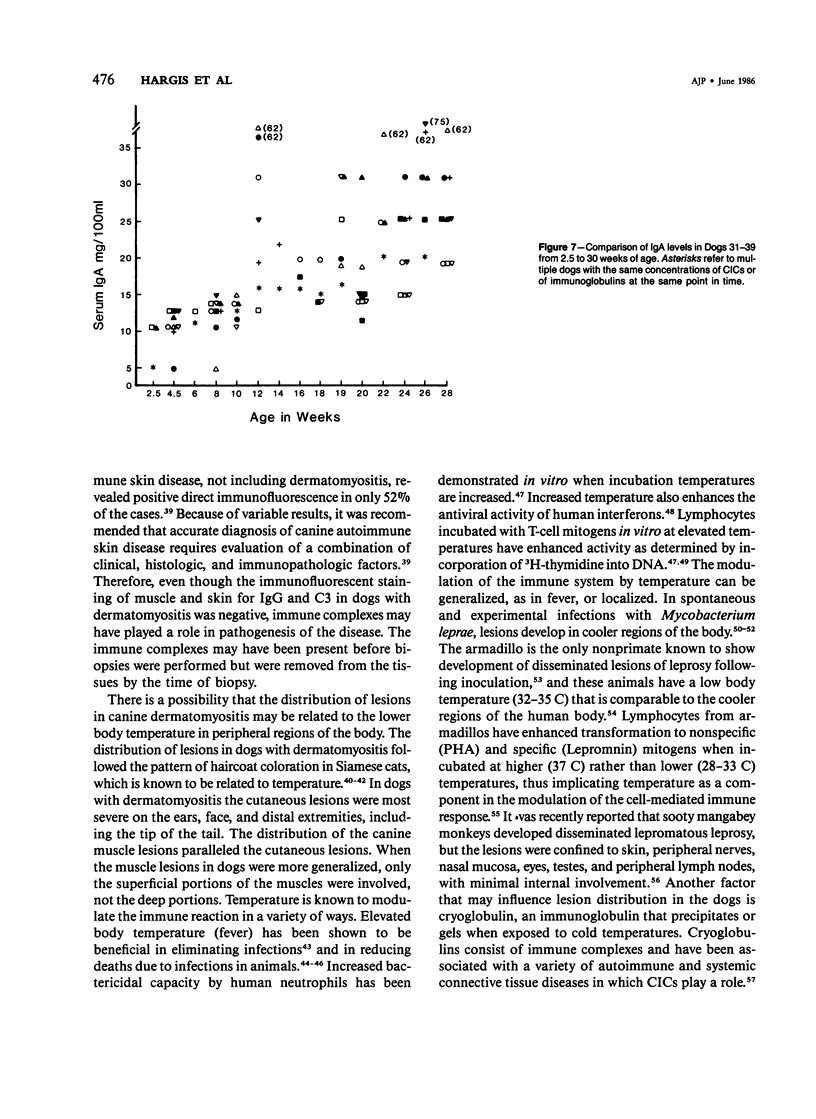
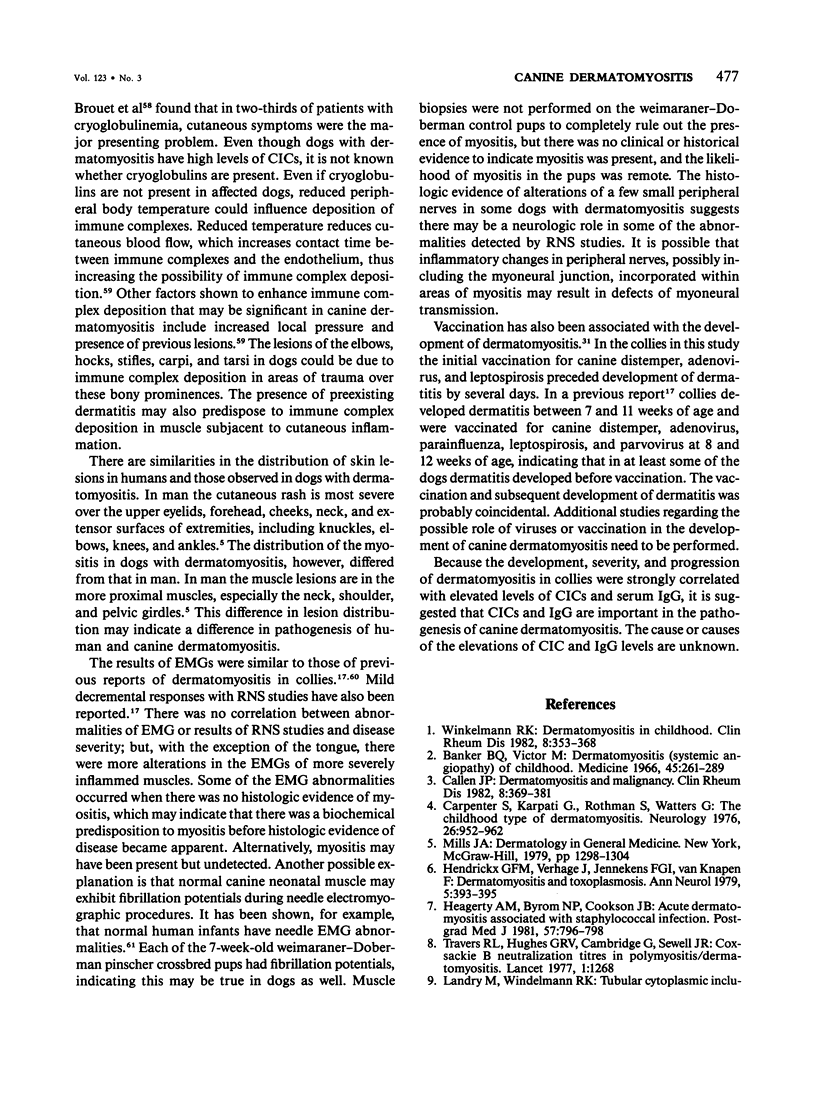
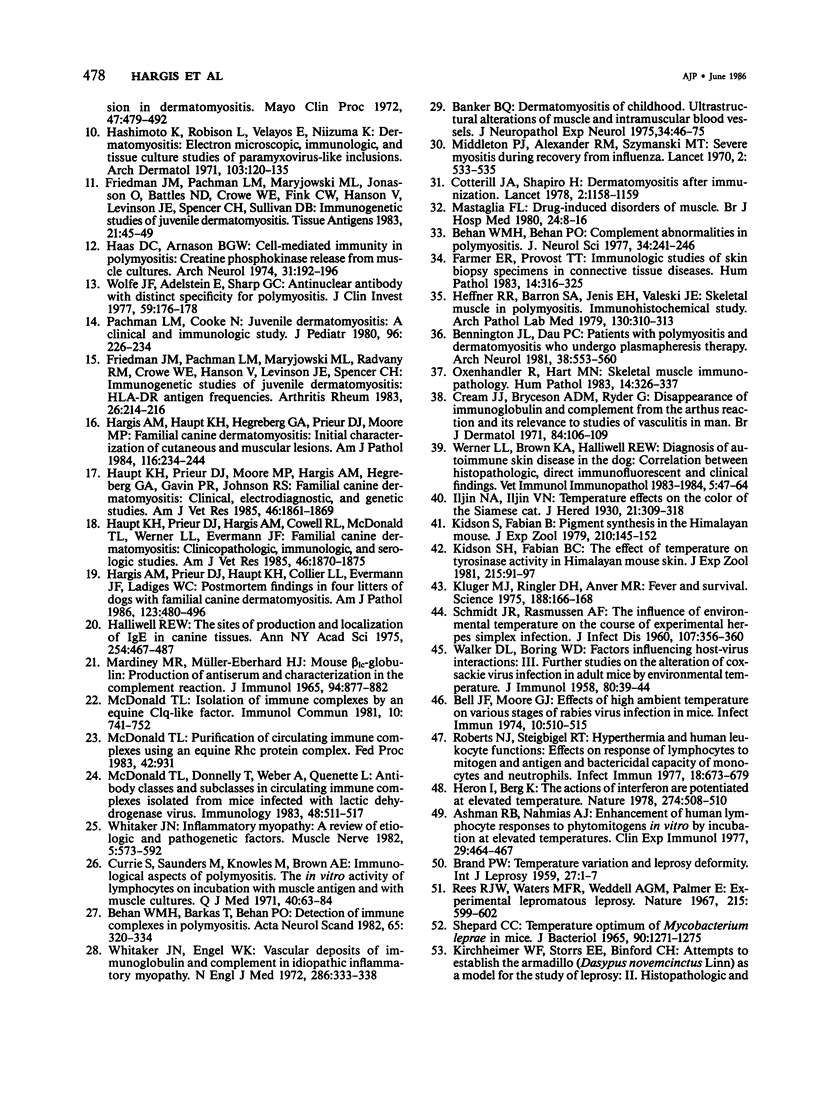
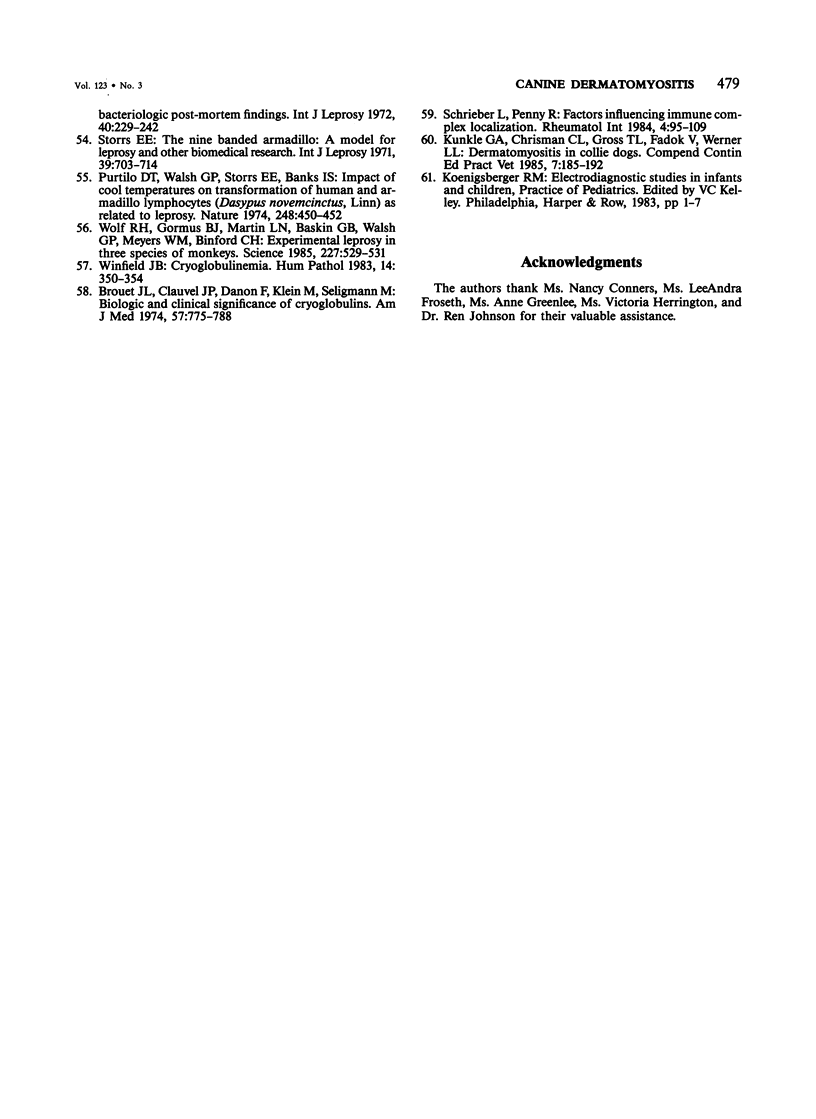
Images in this article
Selected References
These references are in PubMed. This may not be the complete list of references from this article.
- Ashman R. B., Nahmias A. J. Enhancement of human lymphocyte responses to phytomitogens in vitro by incubation at elevated temperatures. Clin Exp Immunol. 1977 Sep;29(3):464–467. [PMC free article] [PubMed] [Google Scholar]
- BRAND P. W. Temperature variation and leprosy deformity. Int J Lepr. 1959 Jan-Mar;27(1):1–7. [PubMed] [Google Scholar]
- Banker B. Q. Dermatomyostis of childhood, ultrastructural alteratious of muscle and intramuscular blood vessels. J Neuropathol Exp Neurol. 1975 Jan;34(1):46–75. doi: 10.1097/00005072-197501000-00005. [DOI] [PubMed] [Google Scholar]
- Banker B. Q., Victor M. Dermatomyositis (systemic angiopathy) of childhood. Medicine (Baltimore) 1966 Jul;45(4):261–289. doi: 10.1097/00005792-196607000-00001. [DOI] [PubMed] [Google Scholar]
- Behan W. M., Barkas T., Behan P. O. Detection of immune complexes in polymyositis. Acta Neurol Scand. 1982 Apr;65(4):320–334. doi: 10.1111/j.1600-0404.1982.tb03089.x. [DOI] [PubMed] [Google Scholar]
- Behan W. M., Behan P. O. Complement abnormalities in polymyositis. J Neurol Sci. 1977 Nov;34(2):241–246. doi: 10.1016/0022-510x(77)90072-7. [DOI] [PubMed] [Google Scholar]
- Bell J. F., Moore G. J. Effects of high ambient temperature on various stages of rabies virus infection in mice. Infect Immun. 1974 Sep;10(3):510–515. doi: 10.1128/iai.10.3.510-515.1974. [DOI] [PMC free article] [PubMed] [Google Scholar]
- Bennington J. L., Dau P. C. Patients with polymyositis and dermatomyositis who undergo plasmapheresis therapy. Pathologic findings. Arch Neurol. 1981 Sep;38(9):553–560. doi: 10.1001/archneur.1981.00510090047005. [DOI] [PubMed] [Google Scholar]
- Brouet J. C., Clauvel J. P., Danon F., Klein M., Seligmann M. Biologic and clinical significance of cryoglobulins. A report of 86 cases. Am J Med. 1974 Nov;57(5):775–788. doi: 10.1016/0002-9343(74)90852-3. [DOI] [PubMed] [Google Scholar]
- Callen J. P. Dermatomyositis and malignancy. Clin Rheum Dis. 1982 Aug;8(2):369–381. [PubMed] [Google Scholar]
- Carpenter S., Karpati G., Rothman S., Watters G. The childhood type of dermatomyositis. Neurology. 1976 Oct;26(10):952–962. doi: 10.1212/wnl.26.10.952. [DOI] [PubMed] [Google Scholar]
- Cotterill J. A., Shapiro H. Dermatomyositis after immunisation. Lancet. 1978 Nov 25;2(8100):1158–1159. doi: 10.1016/s0140-6736(78)92325-5. [DOI] [PubMed] [Google Scholar]
- Cream J. J., Bryceson A. D., Ryder G. Disappearance of immunoglobulin and complement from the Arthus reaction and its relevance to studies of vasculitis in man. Br J Dermatol. 1971 Feb;84(2):106–109. doi: 10.1111/j.1365-2133.1971.tb06851.x. [DOI] [PubMed] [Google Scholar]
- Currie S., Saunders M., Knowles M., Brown A. E. Immunological aspects of polymyositis. The in vitro activity of lymphocytes on incubation with muscle antigen and with muscle cultures. Q J Med. 1971 Jan;40(157):63–84. [PubMed] [Google Scholar]
- Farmer E. R., Provost T. T. Immunologic studies of skin biopsy specimens in connective tissue diseases. Hum Pathol. 1983 Apr;14(4):316–325. doi: 10.1016/s0046-8177(83)80117-8. [DOI] [PubMed] [Google Scholar]
- Friedman J. M., Pachman L. M., Maryjowski M. L., Jonasson O., Battles N. D., Crowe W. E., Fink C. W., Hanson V., Levinson J. E., Spencer C. H. Immunogenetic studies of juvenile dermatomyositis. HLA antigens in patients and their families. Tissue Antigens. 1983 Jan;21(1):45–49. [PubMed] [Google Scholar]
- Friedman J. M., Pachman L. M., Maryjowski M. L., Radvany R. M., Crowe W. E., Hanson V., Levinson J. E., Spencer C. H. Immunogenetic studies of juvenile dermatomyositis: HLA-DR antigen frequencies. Arthritis Rheum. 1983 Feb;26(2):214–216. doi: 10.1002/art.1780260216. [DOI] [PubMed] [Google Scholar]
- Haas D. C., Arnason B. G. Cell-mediated immunity in polymyositis. Creatine phosphokinase release from muscle cultures. Arch Neurol. 1974 Sep;31(3):192–196. doi: 10.1001/archneur.1974.00490390074008. [DOI] [PubMed] [Google Scholar]
- Haegerty A. M., Byrom N. P., Cookson J. B. Acute dermatomyositis associated with a staphylococcal infection. Postgrad Med J. 1981 Dec;57(674):796–798. doi: 10.1136/pgmj.57.674.796. [DOI] [PMC free article] [PubMed] [Google Scholar]
- Hargis A. M., Haupt K. H., Hegreberg G. A., Prieur D. J., Moore M. P. Familial canine dermatomyositis. Initial characterization of the cutaneous and muscular lesions. Am J Pathol. 1984 Aug;116(2):234–244. [PMC free article] [PubMed] [Google Scholar]
- Hargis A. M., Prieur D. J., Haupt K. H., Collier L. L., Evermann J. F., Ladiges W. C. Postmortem findings in four litters of dogs with familial canine dermatomyositis. Am J Pathol. 1986 Jun;123(3):480–496. [PMC free article] [PubMed] [Google Scholar]
- Hashimoto K., Robison L., Velayos E., Niizuma K. Dermatomyositis. Electron microscopic, immunologic, and tissue culture studies of paramyxovirus-like inclusions. Arch Dermatol. 1971 Feb;103(2):120–135. doi: 10.1001/archderm.103.2.120. [DOI] [PubMed] [Google Scholar]
- Haupt K. H., Prieur D. J., Hargis A. M., Cowell R. L., McDonald T. L., Werner L. L., Evermann J. F. Familial canine dermatomyositis: clinicopathologic, immunologic, and serologic studies. Am J Vet Res. 1985 Sep;46(9):1870–1875. [PubMed] [Google Scholar]
- Haupt K. H., Prieur D. J., Moore M. P., Hargis A. M., Hegreberg G. A., Gavin P. R., Johnson R. S. Familial canine dermatomyositis: clinical, electrodiagnostic, and genetic studies. Am J Vet Res. 1985 Sep;46(9):1861–1869. [PubMed] [Google Scholar]
- Heffner R. R., Jr, Barron S. A., Jenis E. H., Valeski J. E. Skeletal muscle in polymyositis. Immunohistochemical study. Arch Pathol Lab Med. 1979 Jun;103(6):310–313. [PubMed] [Google Scholar]
- Hendrickx G. F., Verhage J., Jennekens F. G., van Knapen F. Dermatomyositis and toxoplasmosis. Ann Neurol. 1979 Apr;5(4):393–395. doi: 10.1002/ana.410050416. [DOI] [PubMed] [Google Scholar]
- Heron I., Berg K. The actions of interferon are potentiated at elevated temperature. Nature. 1978 Aug 3;274(5670):508–510. doi: 10.1038/274508a0. [DOI] [PubMed] [Google Scholar]
- Kidson S. H., Fabian B. C. The effect of temperature on tyrosinase activity in Himalayan mouse skin. J Exp Zool. 1981 Jan;215(1):91–97. doi: 10.1002/jez.1402150111. [DOI] [PubMed] [Google Scholar]
- Kidson S., Fabian B. Pigment synthesis in the Himalayan mouse. J Exp Zool. 1979 Oct;210(1):145–152. doi: 10.1002/jez.1402100116. [DOI] [PubMed] [Google Scholar]
- Kirchheimer W. F., Storrs E. E., Binford C. H. Attempts to establish the Armadillo (Dasypus novemcinctus linn.) as a model for the study of leprosy. II. Histopathologic and bacteriologic post-mortem findings in lepromatoid leprosy in the Armadillo. Int J Lepr Other Mycobact Dis. 1972 Jul-Sep;40(3):229–242. [PubMed] [Google Scholar]
- Kluger M. J., Ringler D. H., Anver M. R. Fever and survival. Science. 1975 Apr 11;188(4184):166–168. [PubMed] [Google Scholar]
- Landry M., Winkelmann R. K. Tubular cytoplasmic inclusion in dermatomyositis. Mayo Clin Proc. 1972 Jul;47(7):479–492. [PubMed] [Google Scholar]
- MARDINEY M. R., Jr, MUELLER-EBERHARD H. J. MOUSE BETA-1C-GLOBULIN: PRODUCTION OF ANTISERUM AND CHARACTERIZATION IN THE COMPLEMENT REACTION. J Immunol. 1965 Jun;94:877–882. [PubMed] [Google Scholar]
- Mastaglia F. L. Drug-induced disorders of muscle. Br J Hosp Med. 1980 Jul;24(1):8, 11-6. [PubMed] [Google Scholar]
- McDonald T. L., Donnelly T., Weber A., Quenette L. Antibody classes and subclasses in circulating immune complexes isolated from mice infected with lactic dehydrogenase virus. Immunology. 1983 Mar;48(3):511–517. [PMC free article] [PubMed] [Google Scholar]
- McDonald T. L. Isolation of immune complexes by an equine Clq-like factor. Immunol Commun. 1981;10(8):741–752. doi: 10.3109/08820138109051960. [DOI] [PubMed] [Google Scholar]
- Middleton P. J., Alexander R. M., Szymanski M. T. Severe myositis during recovery from influenza. Lancet. 1970 Sep 12;2(7672):533–535. doi: 10.1016/s0140-6736(70)91343-7. [DOI] [PubMed] [Google Scholar]
- Oxenhandler R., Hart M. N. Skeletal muscle immunopathology. Hum Pathol. 1983 Apr;14(4):326–337. doi: 10.1016/s0046-8177(83)80118-x. [DOI] [PubMed] [Google Scholar]
- Pachman L. M., Cooke N. Juvenile dermatomyositis: a clinical and immunologic study. J Pediatr. 1980 Feb;96(2):226–234. doi: 10.1016/s0022-3476(80)80807-9. [DOI] [PubMed] [Google Scholar]
- Purtilo D. T., Walsh G. P., Storrs E. E., Banks I. S. Impact of cool temperatures on transformation of human and armadilio lymphocytes (Dasypus novemcinctus, Linn.) as related to leprosy. Nature. 1974 Mar 29;248(447):450–452. doi: 10.1038/248450a0. [DOI] [PubMed] [Google Scholar]
- Rees R. J., Waters M. F., Weddell A. G., Palmer E. Experimental lepromatous leprosy. Nature. 1967 Aug 5;215(5101):599–602. doi: 10.1038/215599a0. [DOI] [PubMed] [Google Scholar]
- Roberts N. J., Jr, Steigbigel R. T. Hyperthermia and human leukocyte functions: effects on response of lymphocytes to mitogen and antigen and bactericidal capacity of monocytes and neutrophils. Infect Immun. 1977 Dec;18(3):673–679. doi: 10.1128/iai.18.3.673-679.1977. [DOI] [PMC free article] [PubMed] [Google Scholar]
- SCHMIDT J. R., RASMUSSEN A. F., Jr The influence of environmental temperature on the course of experimental herpes simplex infection. J Infect Dis. 1960 Nov-Dec;107:356–360. doi: 10.1093/infdis/107.3.356. [DOI] [PubMed] [Google Scholar]
- Schrieber L., Penny R. Factors influencing immune complex localisation. Rheumatol Int. 1984;4(3):95–109. doi: 10.1007/BF00541177. [DOI] [PubMed] [Google Scholar]
- Shepard C. C. Temperature optimum of Mycobacterium leprae in mice. J Bacteriol. 1965 Nov;90(5):1271–1275. doi: 10.1128/jb.90.5.1271-1275.1965. [DOI] [PMC free article] [PubMed] [Google Scholar]
- Storrs E. E. The nine-banded armadillo: a model for leprosy and other biomedical research. Int J Lepr Other Mycobact Dis. 1971 Jul-Sep;39(3):703–714. [PubMed] [Google Scholar]
- Travers R. L., Hughes G. R., Cambridge G., Sewell J. R. Coxsackie B neutralisation titres in polymyositis/dermatomyositis. Lancet. 1977 Jun 11;1(8024):1268–1268. doi: 10.1016/s0140-6736(77)92487-4. [DOI] [PubMed] [Google Scholar]
- WALKER D. L., BORING W. D. Factors influencing host-virus interactions. III. Further studies on the alteration of Coxsackie virus infection in adult mice by environmental temperature. J Immunol. 1958 Jan;80(1):39–44. [PubMed] [Google Scholar]
- Werner L. L., Brown K. A., Halliwell R. E. Diagnosis of autoimmune skin disease in the dog: correlation between histopathologic, direct immunofluorescent and clinical findings. Vet Immunol Immunopathol. 1983 Nov;5(1):47–64. doi: 10.1016/0165-2427(83)90031-4. [DOI] [PubMed] [Google Scholar]
- Whitaker J. N., Engel W. K. Vascular deposits of immunoglobulin and complement in idiopathic inflammatory myopathy. N Engl J Med. 1972 Feb 17;286(7):333–338. doi: 10.1056/NEJM197202172860701. [DOI] [PubMed] [Google Scholar]
- Whitaker J. N. Inflammatory myopathy: a review of etiologic and pathogenetic factors. Muscle Nerve. 1982 Oct;5(8):573–592. doi: 10.1002/mus.880050802. [DOI] [PubMed] [Google Scholar]
- Winfield J. B. Cryoglobulinemia. Hum Pathol. 1983 Apr;14(4):350–354. doi: 10.1016/s0046-8177(83)80121-x. [DOI] [PubMed] [Google Scholar]
- Winkelmann R. K. Dermatomyositis in childhood. Clin Rheum Dis. 1982 Aug;8(2):353–368. [PubMed] [Google Scholar]
- Wolf R. H., Gormus B. J., Martin L. N., Baskin G. B., Walsh G. P., Meyers W. M., Binford C. H. Experimental leprosy in three species of monkeys. Science. 1985 Feb 1;227(4686):529–531. doi: 10.1126/science.3917577. [DOI] [PubMed] [Google Scholar]
- Wolfe J. F., Adelstein E., Sharp G. C. Antinuclear antibody with distinct specificity for polymyositis. J Clin Invest. 1977 Jan;59(1):176–178. doi: 10.1172/JCI108616. [DOI] [PMC free article] [PubMed] [Google Scholar]




